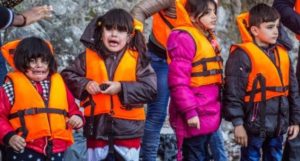Better data vital in protecting migrant children – UN
 More than 1200 child migrants have died since 2014 nearly half of them while attempting to cross the Mediterranean, according the International Organisation for Migration (IOM).
More than 1200 child migrants have died since 2014 nearly half of them while attempting to cross the Mediterranean, according the International Organisation for Migration (IOM).
This represents less than 5 per cent of the total number of migrant deaths recorded during this period by IOM, the UN’s Migration Agency, but the real figure is likely to be much higher.
This is because about 12.5 per cent of all migrants are under the age of 18, and the number of children migrating around the world has been increasing in recent years.
About a quarter of the one million or so migrants who arrived by sea in Italy and Greece in 2015 were children, and, of those arriving in Italy, 72 per cent were unaccompanied.
The new data has sparked a call by UNICEF, IOM, UNHCR, Eurostat, and OECD for better data to help understand the patterns of global migration and develop policies to support vulnerable groups like children.
In a call to action statement this week, the five UN and partner organisations said gaps in data covering refugees, asylum seekers, migrants and internally displaced populations are endangering the lives and wellbeing of millions of children on the move
The statement highlighted the lack of data essential for understanding how migration affects children and their families. It said data on children moving irregularly across borders, and those who have gone missing or lost their lives during their migratory journeys are particularly scarce.
“Protecting children on the move starts with better data,” it said.
The statement confirmed alarming holes in the availability, reliability, timeliness and accessibility of data and evidence that are essential for understanding how migration and forcible displacement affect children and their families.
It said there was recorded information on age for just 56 per cent of the refugee population under UNHCR’s mandate and only 20 per cent of countries or territories with data on conflict-related internally displaced persons (IDP) break it down by age.
Nearly a quarter of countries and territories do not have age disaggregated data on migrants, including 43 per cent of countries and territories in Africa; and lack of information on migrant and displaced children deprives the affected children of protection and services they need.
“We are aware that there are a growing number of children on the move, and that many of these children face significant risks during their journeys,” said Frank Laczko, Director of IOM’s Global Migration Data Analysis Centre, which hosts the Missing Migrants Project.
“In only about 40 per cent of cases where we record a migrant death are we able to estimate the age of the person who died,” he said. “It is extremely difficult to find data disaggregated by age.”
Of the 1,202 deaths of child migrants recorded by the Missing Migrants Project, their age is provided in only 21 per cent of cases.
Often, sources will only mention that the deceased person is a ‘child’ or ‘infant,’ which means that it is difficult to assess which child migrants are most vulnerable. Of the children whose age was provided, the average was just 8 years old at the time of their death, the statement said.
Fifty-eight of these children were infants under the age of 1, and 67 were between 1 and 5 years old.
Though the scarcity of data on child migrants means that it is impossible to say which migratory route is most dangerous for children, the available data indicate that crossing the Mediterranean, especially from Turkey to Greece, is particularly deadly.
At least 396 migrants under the age of 18 died while crossing the Eastern Mediterranean since 2014, with a further 164 recorded on the Central Mediterranean route, and 16 on the Western Mediterranean route.
However, as less than 20 per cent of the more than 15,000 deaths recorded on these routes contain information on age.
Worldwide, the Missing Migrants Project has recorded the deaths of 137 children migrating in Africa, 20 on the US-Mexico border, and 18 on land in Europe. By far the most deaths were due to drowning – 681 children have been lost while crossing a body of water, most of whom perished in the Mediterranean Sea or the Bay of Bengal.
Sixty-eight children died due to vehicle accidents or suffocation during vehicular transport; 50 due to exposure to harsh environments during their journeys; 35 as a result of violence; and 23 due to illness and lack of access to medicine.
Some 803 of the children recorded in the Missing Migrants Project database were originally from Asia, including the Middle East, while another 171 of the dead were from African nations. Sixty-one were from the Americas, while the origin of the remaining 167 children could not be determined.
Laurie Nowell
AMES Australia Senior Journalist












